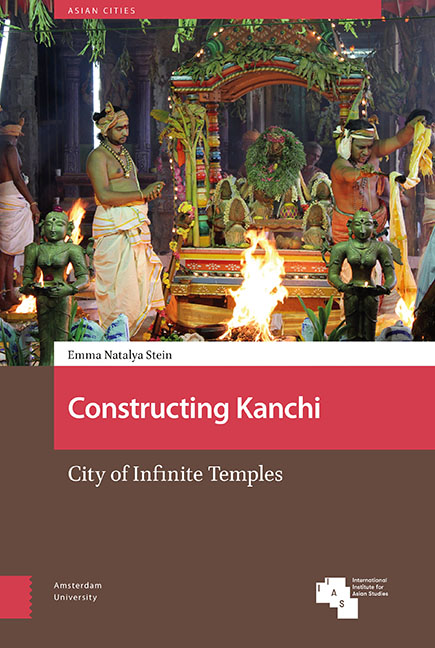Book contents
- Frontmatter
- Dedication
- Table of Contents
- Acknowledgments
- List of Illustrations
- Note on Transliteration, Translation, and Illustrations
- Introduction: All Streets Lead to Temples
- 1 Sandstone and the City: Building Pallava-Kanchi (ca. seventh through ninth century)
- 2 Realignment: Kanchi in the Chola Era (ca. tenth through thirteenth century)
- 3 The City and its Ports
- 4 Kanchi Under Colonialism
- Epilogue: The Living Temple
- Bibliography
- Index
1 - Sandstone and the City: Building Pallava-Kanchi (ca. seventh through ninth century)
Published online by Cambridge University Press: 16 December 2021
- Frontmatter
- Dedication
- Table of Contents
- Acknowledgments
- List of Illustrations
- Note on Transliteration, Translation, and Illustrations
- Introduction: All Streets Lead to Temples
- 1 Sandstone and the City: Building Pallava-Kanchi (ca. seventh through ninth century)
- 2 Realignment: Kanchi in the Chola Era (ca. tenth through thirteenth century)
- 3 The City and its Ports
- 4 Kanchi Under Colonialism
- Epilogue: The Living Temple
- Bibliography
- Index
Summary
Abstract
Chapter One focuses on the last two centuries of the Pallava period (ca. 700-900 CE), when Kanchi became a city marked by the towers of many sandstone temples. This period represents a pivotal moment in the history of South Indian art, when stone supplanted brick as the construction material for elite sacred architecture. Through a rigorous mapping of the city's surviving temples and archaeological remains, this chapter reveals that Kanchi's urban core doubled in size within a single century and demonstrates that the eighth-century city was actually situated west of present-day Kanchi. In the ninth century, growing political instability within Kanchi prompted the Pallavas to concentrate their efforts on outlying areas, while new rulers vied for power inside the city.
Keywords: Kailāsanātha temple, Ekāmbaranātha temple, King Mahendravarman I, Tamil, Sanskrit, Mattavilāsa Prahasana
A set of seven sandstone relief carvings at the Tāṉtōṉṟīśvara temple in Kanchi depicts sensuous figures of courtesans, courtly elites, attendants, and ascetics, who stumble, dance, or wrestle playfully (Ill. 7). Male and female figures flirt and converse. A hand teasingly coils a lock of hair, a torso twists just enough to reveal a proffered flower, and a foot steps forward, its toes curling in a pleasing bend. A princely figure holding a hilted sword approaches a lady whose posture and gesture arrest his movement. The women's torsos are slender, with sloping hips and low centers of gravity. Their flesh is supple and their ornaments thick and weighty. The figures are carved in high relief – they seem to emerge from the wall, twisting as they struggle or shy away from one another.
Whimsical yet also highly refined, these sculptures draw on themes from performing arts and courtly literature, such as the Mattavilāsa Prahasana [‘The Farce of Drunken Sport’], a comedic drama composed in Classical Sanskrit by the renowned king of the Pallava dynasty, Mahendravarman I (ca. 530-680 CE). The sculptures are situated on a main thoroughfare that leads to the bustling Ekāmbaranātha temple, a sacred monument that is mentioned in the Mattavilāsa Prahasana. Through their location in real space and their representation of real character types that were present in the streets of Pallava-era Kanchi, these sculptures straddle the multiple worlds at play in a city where the courtly and the urban intersect.
- Type
- Chapter
- Information
- Constructing KanchiCity of Infinite Temples, pp. 43 - 102Publisher: Amsterdam University PressPrint publication year: 2021



